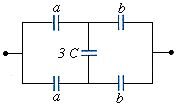Q- A 3.00-g lead bullet at 30.0 degrees C is fired at a speed of 240 m/s into a large block of ice at 0 degrees C, in which it embeds itself. What quantity of ice melts? (Specific heat capacity of lead is 128 J/kg/0C and latent heat of melting of ice is 333*103 J/kg)
Solution Search
. January 2017
Ray Optics: Reflection and refraction through curved surfaces
Q- A solid glass sphere of radius R and index 1.50 is silvered over one hemisphere. A small object is located on the axis of the sphere at a distance 2R from the pole of the un-silvered hemisphere. Find the position of the final image formed by the refracting and reflecting surfaces.
Friction
Q- Two blocks of mass m1 = 12.0 kg and m2 = 18.0 kg connected by a rope of negligible mass are being dragged by a horizontal force F=68.0 N acting on m2. The coefficient of kinetic friction between each block and the surface is 0.100 Determine magnitude of acceleration in the blocks and the tension…
Laser: Power and Intensity
Q- Lasers can be used to drill or cut material. One such laser generates a series of high-intensity pulses rather than a continuous beam of light. Each pulse contains 420 mJ of energy and lasts 10 ns. The laser fires 10 such pulses per second.
(a) What is the peak power of the laser light? The peak…
Newton's Laws
Q- An object of mass 5.00 kg, attached to a spring scale, rests on a frictionless, horizontal surface. The spring scale attached to the rear of a boxcar, has constant reading of 18.0 N when the car is in motion.
(a) Determine the acceleration of the car.
(b) What constant reading will the sprin…
Electrostatics: Coulomb's Law
Q- Two charges Qc and -Qc (Qc = 4 µC) are fixed on the x-axis at x = -6 cm and x = 6 cm, respectively. A third charge Qb = 5 µC is fixed at the origin. A particle with charge q = 0.5 µC and mass m = 6 g is placed on the y-axis at y = 14 cm and released. There is no gravity. Calculate the initial …
Thermodynamics
Q- The initial state of 1.00 mol of a gas is P1 = 6.00 atm, V1 = 5.00 L, and Eint 1 = 790 J, The gas is allowed to expand at constant pressure to a volume of 9.00 L. It is then cooled at constant volume until its pressure is 4.00 atm and its final state becomes P2 = 4.00 atm, V2 = 9.00 L, and Eint 2
Rotational motion
Q- A globe of mass M and radius R can rotate about its fixed vertical axis. A block of mass m is attached by a massless string/pulley system as shown. As the block is released, it causes the globe to spin. If the block starts at rest, at what speed does the block hit the ground after it falls a dis…
Work Power Energy
Q- An object of mass m is traveling on a horizontal surface. There is a coefficient of kinetic friction m between the object and the surface. The object has speed v when it reaches x = 0 and encounters a spring. The object compresses the spring, stops, and then recoils and travels in the opposite di…
Hydrogen Like Atom
Q- An electron in Chromium (Z=24) moves from the n=2 to the n=1 state without emitting a photon. Instead, the excess energy is transmitted to an outer electron (n=4 state), which is emitted. This is called an Auger Electron. Using ionization considerations, calculate the kinetic energy of the Auger …
Magnetic Field
Q- Consider the circuit shown below which is composed of two concentric arcs, with radii R1 = 1 cm and R2 = 3.9 cm and connected by two radial arms. Each arc subtends an angle of 55 degrees. A current of I = 1.7 A flows clockwise in the loop. The loop lies in the x-y plane, and the +z direction is …
Thermal physics
Q-(a) If the pressure of a gas is increased by a factor of 9, while its volume is held constant, by what factor does rms speed change?(b) In Joule’s experiment, the mass of the weights is 2.99 kg, and the insulated tank is filled with 0.137 g of water. What is the increase in the temperature of the …
Newtons Laws of motion: Friction
Q- A car is traveling at 50.0 mi/hr on a horizontal highway.
(a) If the coefficient of static friction between road and tires on a rainy day is 0.100, what is the minimum distance in which the car will stop?
(b)What is the stopping distance when the surface is dry and the coefficient of friction is …
Electrostatics: Coulomb's Law
Q- A rigid, insulating fiber if fixed vertically. A charge Qa = -7 µC is fixed to the fiber at some point. A bead with a hole drilled through its center is slipped over the fiber above Qa and is free to move along the fiber without friction. The mass of the bead is m = 160 g and its charge is Qb. A…


Comments